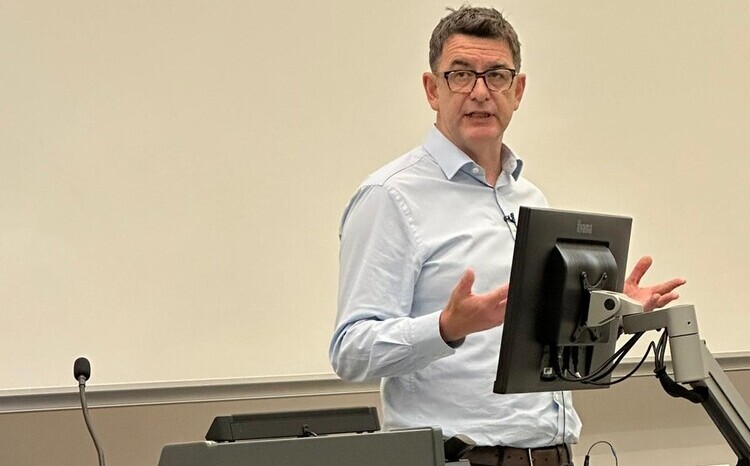EHI interview: Peter Neupert
- 16 February 2009
 |
| Peter Neupert, Microsoft’s vice president for health strategy |
Health IT executives don’t get much more experienced than Peter Neupert, Microsoft’s vice president for health strategy. Recently, he was asked to give evidence to the US Senate about President Barack Obama’s plans to include healthcare IT spending within his multi-billion stimulus for the American economy. During a whistlestop tour of Europe, he took time out of back-to-back meetings to speak to Jon Hoeksma, editor of E-Health Insider.
Peter Neupert’s CV is impressive. In his first stint at Microsoft, he was director in charge of operating systems before becoming responsible for MSNBC as vice president of news and publishing. During the dotcom boom, he led Drugstore.com to a highly successful flotation, returning to Microsoft in 2005 head up the health group.
He is also a man with connections. He was a member of former US president George W Bush’s Information Technology Advisory Council, and is said to be good friends with Microsoft CEO Steve Ballmer.
In January, Neupert was the sole technologist to testify to the US Senate Health, Education, Labor, and Pensions Committee on President Barack Obama’s economic stimulus plan, which includes a $20 billion provision for investment in electronic medical records. On his blog he describes this experience of democracy in action as “awe-inspiring."
Not just any IT
Surprisingly then, his key message to the Senate HELP Committee was that technology does not provide a magic bullet to solve the problems of the US healthcare system.
It’s not that Microsoft is arguing against spending on technology. Far from it; the company is targeting health as a key growth market. “We just want to see smart spending, on technology that will really have impact,” says Neupert.
“There are lots of reasons why technology is not the answer,” he told E-Health Insider. “Health IT alone is not going to fix healthcare without wider healthcare reform.” Instead, Neupert argues, technology must be thought of as a tool that should be “aligned to the health outcomes we want to achieve.”
The objectives should be cast in terms of keeping people out of hospital or better management of chronic conditions, such as diabetes or coronary heart disease, he believes. “The right objective is to say that a significant part of acute care is around treatment of chronic conditions – 60%-65% – and people on the whole do a bad job of self management. That’s what we need to change.”
Neupert compares the new president’s big idea of providing electronic medical records to all Americans to building a rocket; instead of starting with the objective of landing on the moon and then working out what technology will be needed to achieve it.
He also says that when it comes to EMRs, incentives must be thought through. The project makes little sense unless the rules are changed that pay US physicians on the basis of how many patients they see – because consultations using an EMR often take longer.
Mobilising data
Neupert argues it should be possible to put a figure on the benefits of investment on technology. “There is a clear Return on Investment on keeping someone out of hospital, rather than having to admit them.” But he also says the wider aim must be to put the patient at the centre of their healthcare. “The only person on the planet who can completely take responsibility for a condition is the patient.”
Placing patients at the centre of their healthcare means freeing and mobilising data from the various places, systems and organisations in which it presently resides, and giving patients the tools to control who has access to it.
In doing this, Neupert argues that while standards matter, they should not become a sacred cow that holds up progress. “The right standards will evolve,” he argues.
It’s a key Microsoft message that Neupert expands on in his blog: “Unlike the physical world where there is a need for de jure standards—think railroad tracks—in the software world, there is much more flexibility and the standards that work are the ones that evolve from usage and market acceptance.”
Instead, Neupert wants the focus to be on mobilising data that is currently locked into proprietary systems and enclosed within organisational boundaries.
Neupert says this is the rationale of Microsoft’s HealthVault personal health platform, where the central proposition is enabling the individual to connect to many stakeholders to gain a networked effect. “The value is in the number of connections.”
The best demonstration so far, he says, is the Cleveland Clinic “which is connecting with HealthVault all the way down to device connectivity, taking data through to clinical workflow.”
Neupert says Microsoft is talking to potential Western European customers about HealthVault. “The advanced team are here beginning to work with customers,” he says, although he declines to say who they are or when announcements might be made. In the UK, there are suggestions that his meetings have been with trusts and strategic health authorities.
“Five years ago, consumer controlled health records were not on the top of people’s agenda,” he adds. “They are now, due the realisation that they must get people to take control of their health, and personal health records offer the only way to engage with the patient.”
Finding levers for change
The Microsoft Health VP also argues that although they are complex, healthcare systems are not fundamentally ‘different’ when it comes to digitisation. He feels they just have not been forced to change and adapt. The relative lack of competition in healthcare systems “has not required people to change” in the way people in other industries have had to.
Neupert says that where healthcare systems have been subject to market forces the results have sometimes been dramatic. In the competitive field of laser eye surgery, for example, he says that costs have gone from $3000 a procedure to $300.
Neupert also confirmed to EHI that Microsoft is taking its Amalga suite of health enterprise software to the market in the UK. “There are many projects that people have to do that don’t fall in the remit of the National Programme for IT in the NHS. There is money being spent outside NPfIT.”
Recommendations to HELP
Neupert’s testimony to the Senate concluded with the following recommendations for government:
• Encourage innovation in health IT by setting out objective goals and criteria, not by mandating specific technologies or development models.
• Reward innovative doctors who make the internet the foundation of the doctor-patient connection.
• Provide incentives for sharing data.
• Focus on making data interoperable today, not waiting for standards tomorrow, and insist that vendors separate data from applications.
• Enable the private sector to develop an information infrastructure that connects data, systems, and people.
Link
Peter Neupert writes The Healthcare IT Blog




